Dublin Beekeeping Services
Honeybee & Swarm Removal Service
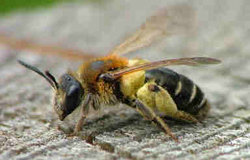
Solitary bee
Solitary Bees
Ireland has 101 species of bee - 14 are well-known social species including the honeybee and bumblebee species. The remainder are lesser known solitary bees that do not form colonies, have no worker bees, and make individual nests.
There are over 70 species of these solitary bees or burrowing bees in Ireland. They look like small honeybees. The males and females emerge early in the spring and mate. Some solitary bees are can be seen very early feeding on dandelions and pussy willows. Then the female makes her nest, on sunny banks where her burrow is 10 to 15 cm long, other species build in hollow stems or in pithed stems like bramble or elder. Leafcutter bees build their nests from discs of leaves, often cut from rose leaves. Some of these bees also construct their nests in holes in paths, the sides of sand pits or in coastal cliffs. Others are opportunists, utilizing almost any cavity of a suitable size, for example nail holes, and holes on masonry, beetle emergence burrows in timber and even the insides of locks.
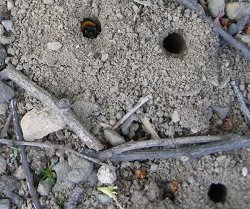
Miner bee
Life cycle
They make burrows, lay a single egg on a ball of pollen and honey for food and the young bee's later hatch. They favour sandy soil as it is dry and the young don't drown. They tend to favour the same site each year.
They are harmless although they do have a very mild sting but rarely use it. For a bee to sting you would have to squeeze a bee between your fingers! They just buzz around when disturbed.
They are a curiosity and after the initial period of activity as they lay eggs, they will be less noticeable.
You can buy specifically designed nest boxes for Solitary Bees, or make one yourself with hollowed out garden canes. All you need to do is place the bee nest box in a sunny, sheltered, south-facing position in the garden (under the eaves of a garden shed is ideal) and you will attract nest-seeking females early spring. The bees are great fun to watch and do an excellent job in the garden. In late September, put the nest containing the occupied tubes in an unheated garden shed or garage for safe overwintering. In the following March, return the nest to the garden to allow the new bees to chew their way out and start all over again.
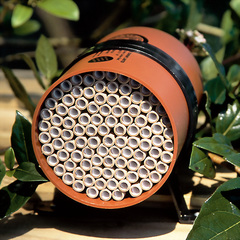
Solitary bee nesting cylinder
No work is required - if the nest boxes are in the garden at the right time the bees will find them.
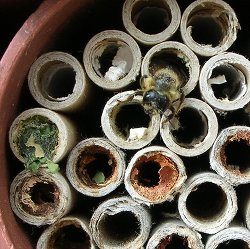
Mason bee
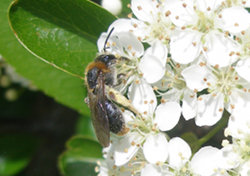
Solitary bee